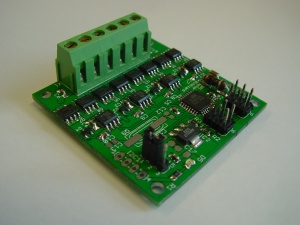Difference between revisions of "Motor"
(No difference)
| |
Revision as of 17:13, 11 May 2012
This is the documentation page for the SPI_motor board.
Overview
This board enables you to control two regular (brushed) DC motors, or one stepper motor.
Assembly instructions
None: the board comes fully assembled.
Specifications
Possible Configurations
External resources
Datasheets
Additional software
Related projects
Pinout
For the SPI connector see: SPI_connector_pinout.
The output connector is connected as follows:
(Looking at the business end of the connector, counting from left to right)
| pin | function |
|---|---|
| 1 | Output A1 |
| 2 | Output A2 |
| 3 | Output B1 |
| 4 | Output B2 |
| 5 | GND |
| 6 | Vin |
Jumper
LEDs
The only LED is a power LED.
jumper settings
See solder jumpers on how to change the solder jumper.
By changing the solder jumper SJ1, you can make connector SPI1 (nearest to the board edge) into the ICSP programming connector for the ATmegaxx8 on the board.
Protocol
For the intro to the SPI and I2C protocols read: SPI versus I2C protocols
The board specific protocol can be found here: DIO_protocol
You should also read the General_SPI_protocol notes.
For arduino, a sample PDE is available, called ardemo_lcd.pde, also at BitWizard software download directory .
This is a demo to send things using SPI to the lcd board. The SPI routines there are applicable for the DIO, 3FETS and 7FETS boards as well.
The software
Default operation
Future hardware enhancements
Future software enhancements
TODO: write a library to make handling this board easy.
Changelog
1.0
- Initial public release
